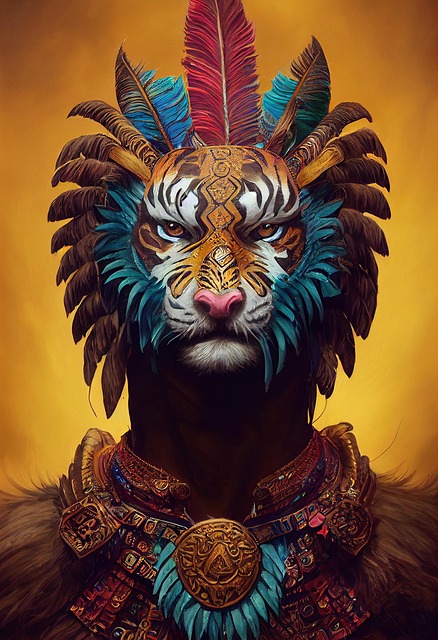# Exploring the Boundaries of AI Art: A Journey Through Machine-Generated Visual Masterpieces
The intersection of technology and creativity is becoming increasingly blurred, particularly with the rise of artificial intelligence (AI) in the art world. As machine-generated visual masterpieces begin to capture the attention of critics, collectors, and casual observers alike, a profound transformation in the artistic landscape is unfolding. This article delves into the multifaceted ways AI is reshaping art, examining its implications for creativity, authorship, and the future of artistic expression.
## The Evolution of AI in Art
Initially, AI’s foray into the realm of art was met with skepticism. Early experiments involved simple algorithms that could mimic styles or generate rudimentary images based on predefined parameters. However, advancements in machine learning, particularly deep learning and neural networks, have propelled AI into a new era of creativity. Programs like DeepArt, DALL-E, and Midjourney have showcased the ability of machines to produce intricate, visually stunning works that often rival those created by human artists.
One of the most significant breakthroughs came with the introduction of Generative Adversarial Networks (GANs). These algorithms consist of two neural networks—the generator and the discriminator—that work in tandem to create and evaluate images. The generator produces images, while the discriminator assesses their authenticity, leading to a continuous cycle of improvement. This process allows AI to learn from vast datasets of existing artwork, enabling it to generate pieces that are not only aesthetically pleasing but also conceptually rich.
In addition to GANs, the advent of style transfer technology has further expanded the possibilities of AI art. By analyzing the style of one image and applying it to the content of another, AI can create unique compositions that blend different artistic influences. This technique has democratized art creation, allowing individuals without formal training to experiment with artistic expression in ways previously thought impossible.
## The Role of Creativity and Authorship
As AI continues to evolve, questions about creativity and authorship have emerged, challenging traditional notions of what it means to be an artist. Historically, art has been viewed as a deeply human endeavor, rooted in personal experience and emotional expression. However, the rise of AI-generated art prompts us to reconsider these definitions. Can a machine truly be creative, or is it merely a sophisticated tool that reflects the intentions of its programmers?
This debate has sparked discussions among artists, critics, and philosophers alike. Some argue that AI lacks the consciousness and emotional depth necessary for genuine creativity. They contend that while machines can produce visually appealing works, they do so without the inherent understanding of context, culture, and human experience that informs traditional art. Others, however, assert that creativity is not solely the domain of human beings. They posit that AI can offer new perspectives and challenge existing paradigms, pushing the boundaries of artistic expression.
Artistic collaboration between humans and machines is becoming increasingly common. Many contemporary artists are embracing AI as a co-creator, utilizing algorithms to enhance their own creative processes. This partnership allows for a fusion of human intuition and machine efficiency, resulting in innovative works that reflect a synthesis of both worlds. In this sense, AI can be seen as an extension of the artist’s toolkit, rather than a replacement for human creativity.
## The Future of AI Art
Looking ahead, the future of AI art is poised for rapid evolution, with implications that extend beyond aesthetics. As technology continues to advance, the potential for AI to influence various art forms—such as music, literature, and performance—becomes increasingly feasible. The integration of AI into these domains could lead to entirely new genres and movements, reshaping the cultural landscape in profound ways.
Moreover, the commercialization of AI-generated art is gaining traction. Galleries and auction houses are beginning to feature machine-generated works, attracting attention from collectors eager to invest in this burgeoning field. Notably, in 2018, an AI-generated portrait titled “Edmond de Belamy” sold at auction for an astonishing $432,500, signaling a shift in the perception of value in the art market. This trend raises important questions about the commodification of creativity and the role of technology in determining artistic worth.
Ethical considerations also come to the forefront as AI art continues to proliferate. Issues surrounding copyright, ownership, and the potential for bias in algorithmic outputs are critical discussions that must be addressed. As AI-generated art becomes more prevalent, it is essential for stakeholders in the art community to establish guidelines that protect both artists and consumers while fostering innovation.
In conclusion, the transformation of art through AI is a captivating journey that invites us to reconsider the very essence of creativity and authorship. As machines increasingly participate in the artistic process, the boundaries of what constitutes art are being redefined. This evolution not only enriches the artistic landscape but also challenges us to explore the implications of technology on our understanding of creativity. As we navigate this uncharted territory, the dialogue between human and machine will undoubtedly shape the future of artistic expression in ways we are only beginning to comprehend.

